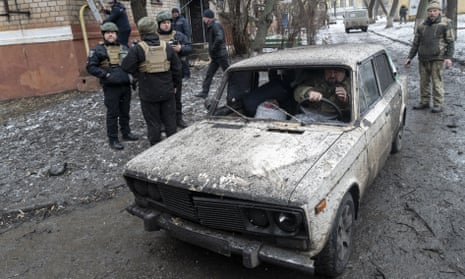Russian forces are attempting to tie down Ukrainian forces with fighting in the eastern Donbas region as Moscow assembles additional troops there for an expected offensive in the coming weeks, perhaps targeting the Luhansk region, Ukraine has said.
Weeks of intense fighting continued to rage around the city of Bakhmut and the nearby towns of Soledar and Vuhledar, Ukraine’s presidential office said.
Moscow’s forces are located in the Donetsk region, which with neighbouring Luhansk region makes up the Donbas region, an industrial area bordering Russia.
“The battles for the region are heating up,” said Pavlo Kyrylenko, the governor of Donetsk, in televised remarks. “The Russians are throwing new units into the battle and eradicating our towns and villages.”
In Luhansk, fellow governor Serhiy Haidai said shelling there had subsided because “the Russians have been saving ammunition for a large-scale offensive”.
Speaking to the Vot Tak news outlet, he said “more and more” Russian reservists were heading towards Luhansk, after reports that Moscow had been building up tanks and personnel in the Luhansk oblast in recent months.
“Probably the minimum they need is 10 days to gather the reserves,” said Haidai, suggesting an offensive could happen in the second half of February.
The warnings came as the UN secretary general, António Guterres, said: “The prospects for peace keep diminishing. The chances of further escalation and bloodshed keep growing.
“I fear the world is not sleepwalking into a wider war. I fear it is doing so with its eyes wide open.”
Ukraine’s general staff has recently reported the arrival of medical reinforcements from Russia to treat wounded military personnel in the occupied Luhansk oblast, supporting assessments – including by the Institute for the Study of War – that Russian forces are preparing for a renewed offensive focused on Luhansk.
In an interview with the Financial Times, Kyrylo Budanov, the head of Ukrainian military intelligence, who has been tipped to take over the Ministry of Defence, also said the western area of the Luhansk region was likely to be the focus of any new Russian offensive.
That offensive, he said, would most likely be launched by “proper mechanised brigades” rather than the ill-trained reservists and Wagner mercenaries who have been suffering heavy casualties in recent battles.
Russia is expected to rely on more advanced T-90 tanks for the coming offensive, some of which have already been moved to the Donbas region, with some analysts pointing to the appointment of Gen Valery Gerasimov as overall commander of Russian forces in Ukraine, whose background is in tank warfare.
Video footage from Russian media in December showed what appeared to be newly arrived T-90s in Luhansk as part of the buildup.
The warnings came as the UK’s Ministry of Defence said Russia was continuing to make small advances in its efforts to encircle the Donbas city of Bakhmut. “While multiple alternative cross-country supply routes remain available to Ukrainian forces, Bakhmut is increasingly isolated,” the ministry said on Twitter.
Writing in his Futura Doctrina newsletter, retired Australian general Mick Ryan, who has been a perceptive commentator on the war in Ukraine, also suggested that “the east is the most likely location for Russian attacks, although attacks in the south are also possible”.
He said: “However, Russian forces might use attacks in the south as feints or demonstrations to draw away Ukrainian forces in the east before launching their main effort in the Donbas. At the same time, if they have sufficient reserves, Russian might be able to reinforce attack in the south if it is sufficiently successful.”
Ryan’s comments are in line with other military analysts who say the Kremlin’s forces may be checking Ukraine defences for weak points or could be making a feint while preparing for a main thrust through southern Ukraine.
Vladimir Putin is hungry for some battlefield success, especially securing illegally annexed territory in eastern Ukraine, to mark the anniversary of his invasion on 24 February. Russian forces made gains in the first few months of the war, though they failed to clinch their main objectives and were then driven back from large areas by a Ukrainian counteroffensive.
Ukraine’s presidential office said on Monday that at least one civilian had been killed and 10 others wounded by Russian shelling over the past 24 hours.
The latest alarms over a new significant Russian offensive came as it emerged that any replacement of Ukraine’s defence minister, Oleksii Reznikov, announced over the weekend would not take place this week.
“We are waiting for the appointment of the heads of the ministry of internal affairs and security service of Ukraine. The personnel changes in the defence sector will not take place this week,” David Arakhamia, who is the head of Volodymyr Zelenskiy’s party, said on social media.
On Sunday evening, Arakhamia said Budanov would replace Reznikov as defence minister. The announcement came after a large-scale corruption scandal in the defence ministry.
According to Arakhamia, Reznikov, 56, will be appointed minister for strategic industries.
Another Ukrainian lawmaker from the presidential party, Mariana Bezugla, said on Facebook there would be no reshuffles this week while the government was evaluating risks before an expected Russian offensive.
Anita Anand, the Canadian defence minister, tweeted on Sunday that the first Leopard tank Canada was donating to Ukraine had arrived in Poland. It is part of a broad tank commitment by Ukraine’s western allies to help it defeat Russia.
Training the Ukrainian military in how to use the tank was due to begin soon, Anand said, as allies raced to get Ukraine’s forces ready before the looming offensive.
Associated Press and AFP contributed to this report
